Tetramorium angulinode Santschi
 Type location Congo (Tetramorium
(Xyphomyrmex) angulinode n. sp., Santschi, 1910c: 385, illustrated,
all
forms) collected at Brazzaville, by A. Weiss - see below Type location Congo (Tetramorium
(Xyphomyrmex) angulinode n. sp., Santschi, 1910c: 385, illustrated,
all
forms) collected at Brazzaville, by A. Weiss - see below
junior synonyms
daphnis (Xiphomyrmex angulinode Sants v Daphnis
n. var, Santschi, 1920b: 16, illustrated, worker & queen) from Zimbabwe,
Hillside, Bulawayo, G Arnold - see http://www.antweb.org/specimenImages.do?name=casent0901163
humerosum (Tetramorium humerosum, Emery,
in litteris, Bernard, 1952: 13, illustrated, worker & queen)
from Cameroun, collector L. Conradt, 1895 - queen see http://www.antweb.org/specimenImages.do?code=casent0914276
papyri (Xiphomyrmex
papyri spec. nov., Weber, 1943c: 374, illustrated, queen) from South
Sudan, in the Sudd while on a river steamer - no images on Antweb (April 2015).
(see Bolton, 1995)  . .
|
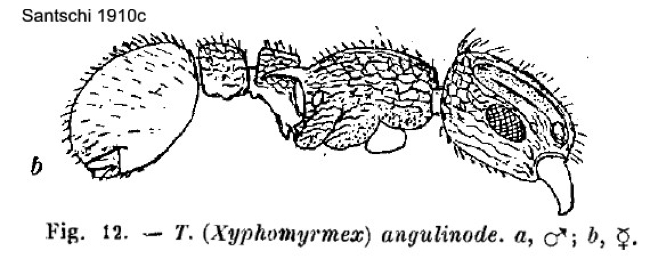 Santschi's
(1910c) description is at Santschi's
(1910c) description is at  and and  . Santschi's (1920b) description of daphnis
is at . Santschi's (1920b) description of daphnis
is at  . Arnold (1926: 279) gave
a fuller description of daphnis, this is at . Arnold (1926: 279) gave
a fuller description of daphnis, this is at  . Weber's (1943c) description of the papyri
queen is at . Weber's (1943c) description of the papyri
queen is at  . Bernard's (1952)
description of humerosum is at . Bernard's (1952)
description of humerosum is at  - Bolton pointed out that this largely
describes a specimen of ataxium, whereas the type specimens
were what Bolton decided was angulinode. Bolton's modern
description (1980) is at - Bolton pointed out that this largely
describes a specimen of ataxium, whereas the type specimens
were what Bolton decided was angulinode. Bolton's modern
description (1980) is at  . .
The form named as nullispinum from Nigeria
(Bolton, 1980: 241, worker) appears in Bolton's Catalogue, without any
supporting details, as synonymised under angulinode (Bolton,
1995: 412, "new synonymy"). From Bolton's original description this
appears to be incorrect and I have kept Tetramorium
nullispinum separate.
|
The definitive angulinode, according to Bolton
(1980) is a widespread but seemingly uncommon species usually
inhabiting savannah or grassland, usually nesting amongst the roots of
grasses and low plants. Interestingly, in view of the foregoing,
Bernard (1952) listed the finding of a queen of "Xyphomyrmex
angulinodis" from the Kéoulenta savanna; this seems to have passed
unnoticed by Bolton (1980).
From Nigeria Bolton listed findings at CRIN
(himself), and also from Mokwa (C. Longhurst) and IITA (B.R.
Critchley), but he did not list my specimens, which I found at CRIN
nesting in the ground and the drive area of a domestic garden (my 1980
CRIN Research Bulletin report as Xiphomyrmex T¹, deposited in
the British Museum in 1976). Ghana records from Bolgatanga
(P.M. Room) and the Agricultural Station, Pokoase (W. Belfield; misspelt by Bolton, 1980). Otherwise known from scattered
locations throughout sub-Saharan Africa. Forel (1911f) reported angulinode
from Zaïre, Kinshasa [Leopoldville] by Dr Dubois.
Bolton's (1980) list included Cameroun and he
explained that the specimens were those discovered among the Forel
collection in Geneva and bearing a label "humerosum Em." by
Bernard (1952). Bernard himself decribed how he had specimens collected
from Mt. Nimba which he could not identify. Then he came across the "humerosum"
with the label by Emery but which Emery had not published and he
(Bernard) did not know if there were others in the collection in
Bologna. As Bolton related, the description, with illustration, given
by Bernard is clear but does not match the Emery-labelled specimen. The
availability of Antweb images (uploaded 20.ii.2014) of the Bernard-Mt
Nimba specimens showed that I misunderstood what Bolton wrote. To
correct that: the
Emery material (from Cameroun, collected by Conradt) is angulinode and the Mt. Nimba material is workers of Tetramorium
ataxium.
|
 There is a clear discrepancy between the drawings, both in
the first publication and later, given by Santschi (1910c, 1920b) and
that given by Bolton (1980). There is a clear discrepancy between the drawings, both in
the first publication and later, given by Santschi (1910c, 1920b) and
that given by Bolton (1980).
|
|
 Bolton,
in common with all his works, gave no source for the depicted specimen.
In this instance, he did not refer specifically to Santschi's
description or figure. The Bolton drawing matched my earlier drawing of
specimens I saw in Nigeria, and the illustration given by Weber (1943c)
of the pedicel of the queen of his new species Xiphomyrmex papyri. Bolton,
in common with all his works, gave no source for the depicted specimen.
In this instance, he did not refer specifically to Santschi's
description or figure. The Bolton drawing matched my earlier drawing of
specimens I saw in Nigeria, and the illustration given by Weber (1943c)
of the pedicel of the queen of his new species Xiphomyrmex papyri.
The Santschi type form also has quite abundant
moderately long fine erect hairs all over, whereas, the papyri
(Bolton) form has sparser, short, thick erect hairs on the head and
alitrunk. The sculpturation on the head of the type form is of fine and
densely packed longitudinal striations, wheras, the papyri form
has coarser and much less densely packed longitudinal striations.
With the release on Antweb of photographs of the
holotype, below, it is clear that Bolton's illusttration was not of
the type form.
|
 The photomontage of
the holotype worker is collated from http://www.antweb.org/specimen.do?name=zfmkhym20096255. The photomontage of
the holotype worker is collated from http://www.antweb.org/specimen.do?name=zfmkhym20096255.
|
Oxford University Museum
specimens
Tetramorium angulinode
B Taylor det.
|
Senegal
Tambacounda
B Ndiaye
|
13.viii.2009
Bambaraya
13°06'30"N
12°05'18" W
|
Bambaraya13-VIII-09
St 4 P4F
Soudanian savannah, pitfall traps
|
2
|
 |
Tetramorium angulinode
B Taylor det.
|
Senegal
Tambacounda
B Ndiaye
|
13.v.2009
Bangouraya
13°05'02" N
12°08'01" W
|
Bangouraya 13-V-09
St 10 P1F
Soudanian savannah, pitfall traps
|
1
|
 |
Tetramorium angulinode
B Taylor det. |
Senegal
Ferlo
B Ndiaye
|
x.2010
Katané
15.48° N
14.08° W
|
Katané X 2010 T3P9
Sahelian savannah, pitfall traps
|
4
|
 |
Tetramorium angulinode
B Taylor det.
Type form
|
Senegal
Lamine Diamé
40
|
08.v.2012
Thiés
14°45'N
17°03'W
|
Pout
V11
pitfall 2
tube 04
|
2
|
 |
Tetramorium angulinode
B Taylor det. |
Benin
J-F Vayssieres
RVA 3040.6
|
20.ii.2013
Koro
09°22'21'' N
02°40'13'' E
|
Mangifera indica orchard
prey of Oecophylla longinoda
1000-1100 h
|
1
|
 |
Tetramorium angulinode
B Taylor det.
|
Cameroun
A Fotso Kuate
Tetramorium sp1
|
10.v.2007
Awae II
03°54'30" N
11°25'58"
|
Pitfall in fallow
|
1
|
 |
Tetramorium angulinode
B Taylor det.
|
Cameroun
A Fotso Kuate
Tetramorium spD
|
29.ix.2007
Boga
03°54'30" N
11°25'58"
|
Quadrat in fallow
|
1
|
 |
Tetramorium angulinode
B Taylor det.
|
Cameroun
A Fotso Kuate
Tetramorium sp19
|
16.i.2008
Awae II
03°54'30" N
11°25'58"
|
Quadrat in forest
|
1
|
 |
Tetramorium angulinode
B Taylor det.
|
Central African
Republic
P Annoyer
Di on reduviid
|
20.i.2005
Dzanga-Sangha
03°55’13.2" N
16°36’46.1" E
|
536m; U.V : 2h-6h,
après Sefka (entre Bambio et croisement Nola/Berberati),
dans layon forestier; from on a reduviid bug; collected in forest, 1st
hour of the morning
|
2
|
 |
Tetramorium angulinode
B Taylor det.
|
Congo
E Zassi
17-t-1
|
4-5.ii.2008
Lésio-Louna
03°20'12.0" S
015°28'43.6" E
|
Village Mah; 24h
pitfall trap
|
1
|
 |
Tetramorium angulinode
Gabon 187 form
B Taylor det. |
Gabon
Y Braet
Gabon 187
|
17-22.v.2006
Pongara
00°34' N
09°19' E
|
Leaf litter, winkler
funnel
|
1
|
 |
|
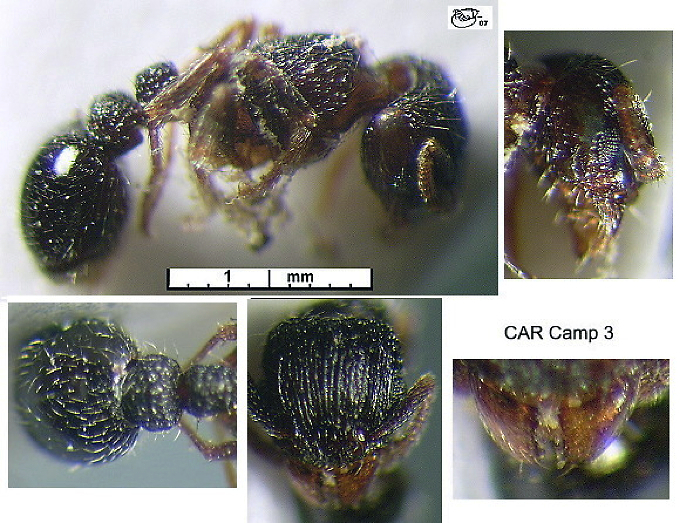 The answer may lie in Santschi's style of designating
varieties and "stirps" rather than new species for forms with somewhat
similar overall morphology. The illustration from Santschi (1920b) is a
good example. Both Santschi's own description of the type and Arnold's
description of daphnis, are matched by the specimens I have
from the Central African Republic and Congo. The answer may lie in Santschi's style of designating
varieties and "stirps" rather than new species for forms with somewhat
similar overall morphology. The illustration from Santschi (1920b) is a
good example. Both Santschi's own description of the type and Arnold's
description of daphnis, are matched by the specimens I have
from the Central African Republic and Congo.
More detailed photomontages of these can be seen on the
linked page - T.
angulinode type form.
TL ca 3.30 mm, HL 0.75, HW 0.65, CI 87,
SL 0.42, SI 65, PW 0.58
|
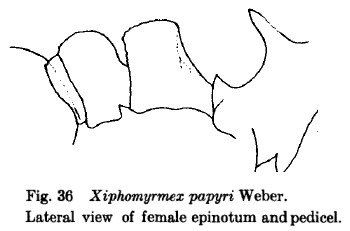
Tetramorium papyri Weber ?
Type location South Sudan (Xiphomyrmex papyri,
Weber, 1943c: 374, illustrated, queen) from on a ship in the Sudd,
Upper White Nile, 8.vii.1939.
Weber's (1943c) description of the papyri queen
is at  . Bolton's modern
description (1980) is at . Bolton's modern
description (1980) is at  . .
|
  Nigeria specimens (as Xiphomyrmex species
T¹, Taylor, 1980a: 63). WORKER. TL 2.24 mm, HL
0.56, HW 0.50, CI = 89, SL 0.34, SI = 68, PW 0.40. This has the quite
narrow petiole profile, much finer sculpturation and a generally pale
yellow-brown colour with the gaster darker. Head, dorsal alitrunk and
pedicel rugoreticulate; lateral alitrunk punctate. Erect hairs
moderately abundant and long. Antennal scrobes defined only as
extensions of the frontal carinae. Propodeal spines moderately long and
broad; metapleural lobes short, triangular. Petiole with vertical
anterior and posterior faces; dorsum short, slightly convex;
subpetiolar tooth acutely triangular. Nigeria specimens (as Xiphomyrmex species
T¹, Taylor, 1980a: 63). WORKER. TL 2.24 mm, HL
0.56, HW 0.50, CI = 89, SL 0.34, SI = 68, PW 0.40. This has the quite
narrow petiole profile, much finer sculpturation and a generally pale
yellow-brown colour with the gaster darker. Head, dorsal alitrunk and
pedicel rugoreticulate; lateral alitrunk punctate. Erect hairs
moderately abundant and long. Antennal scrobes defined only as
extensions of the frontal carinae. Propodeal spines moderately long and
broad; metapleural lobes short, triangular. Petiole with vertical
anterior and posterior faces; dorsum short, slightly convex;
subpetiolar tooth acutely triangular.
Found at the Cocoa Research Institute of Nigeria, Idi Ayunre, nesting
in the ground and the drive area of a domestic garden, collector B
Taylor, 1976. Not listed by Bolton (1980), although deposited with him
by me in 1976.
|
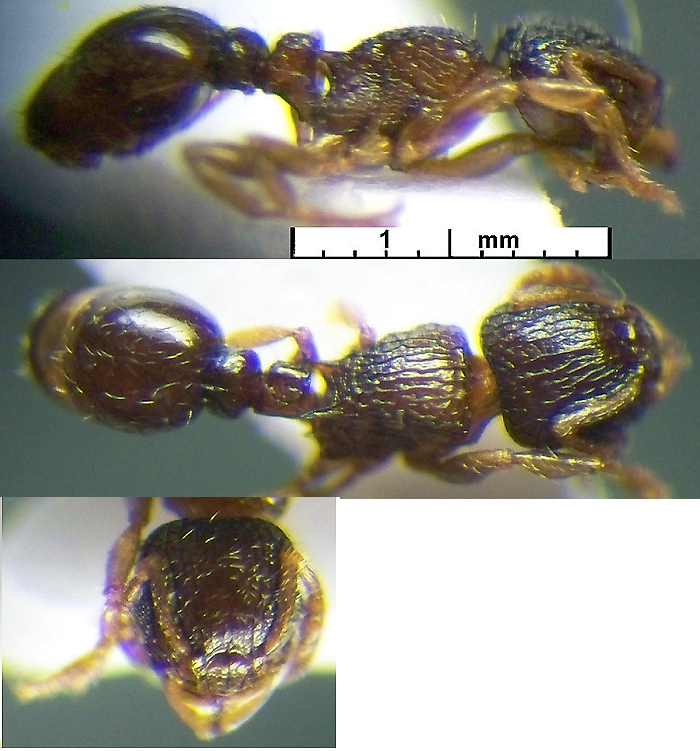 Photomontages of
this form from Congo can be seen on the
linked page - T.
angulinode Santschi papyri Weber. Photomontages of
this form from Congo can be seen on the
linked page - T.
angulinode Santschi papyri Weber.
|
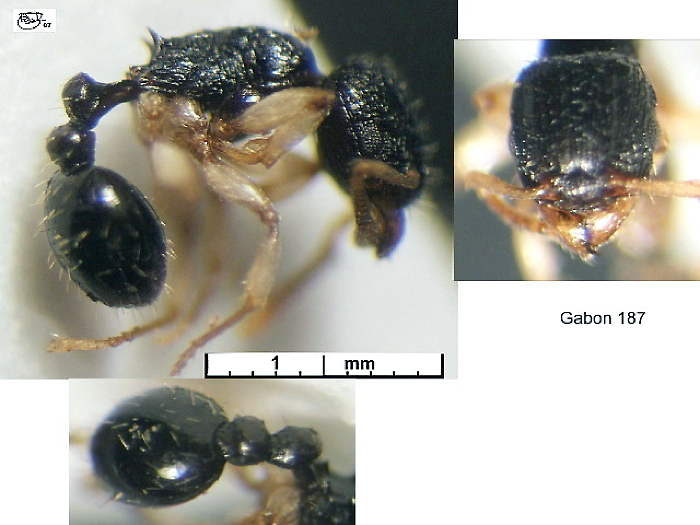 Photomontages of a similar but darker form from Gabon
also can be seen on the
linked page . Photomontages of a similar but darker form from Gabon
also can be seen on the
linked page .
|
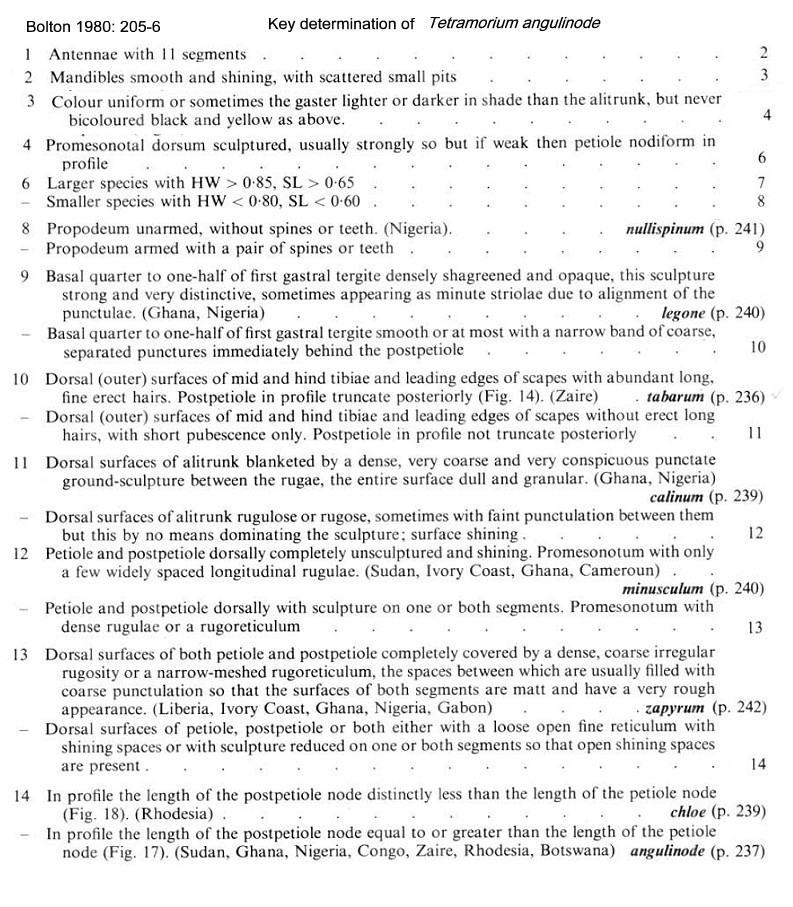
|
|